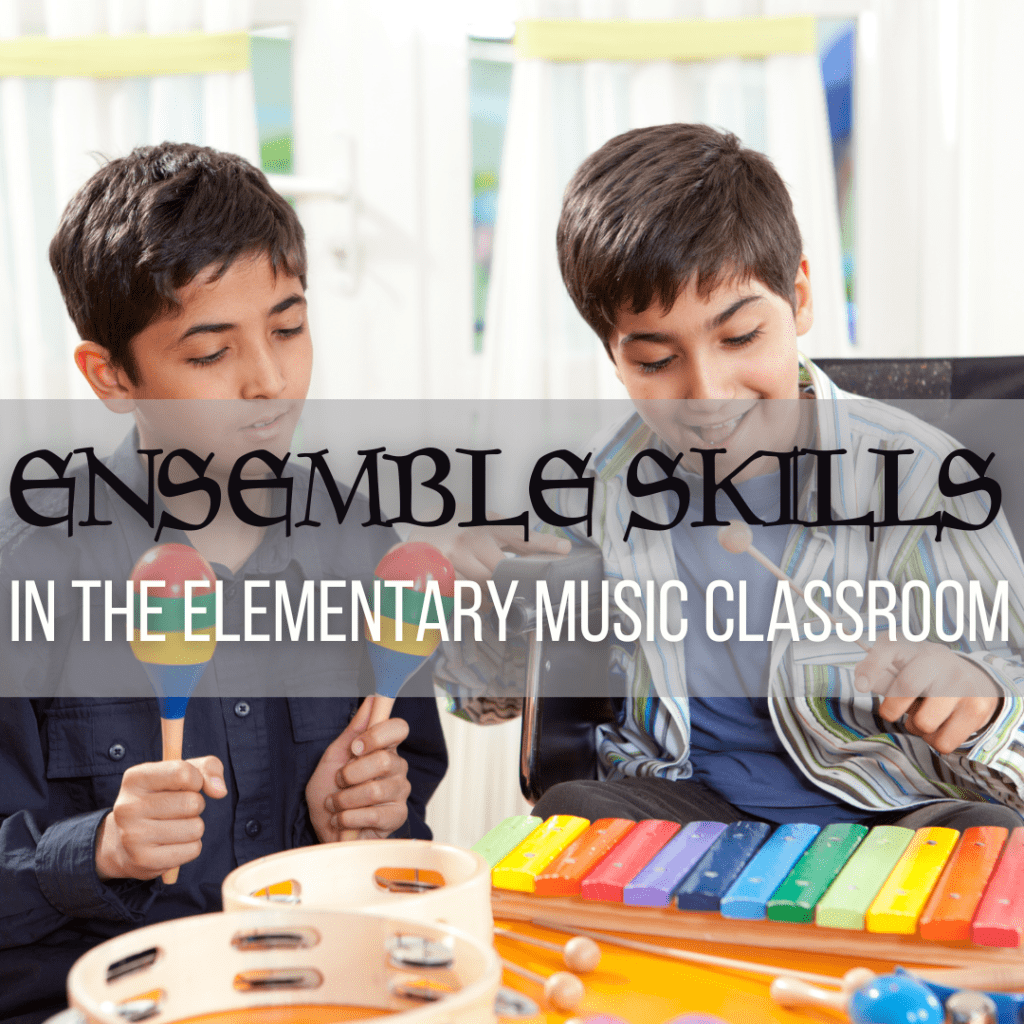Learning to play in an ensemble is a valuable skill that teaches elementary music students the importance of listening, collaboration, and teamwork. Developing ensemble skills helps kids learn how to work together, actively listen, and adjust their performance accordingly. The benefit of building ensemble skills extends far beyond the music classroom, preparing students for success in various aspects of life, such as communication, problem-solving, and adaptability. While it can be challenging to build those skills, it can also be incredibly rewarding for you and your students!
Emphasize the Importance of Listening in the Elementary Music Classroom
In an elementary music ensemble, listening is one of the most important ensemble skills students need to develop. I’m constantly surprised by how many students aren’t taught to listen first. You might notice this yourself when teaching a song and students start singing or playing immediately, even without hearing the full song. Ensemble skills in the music classroom should include teaching students to listen carefully to themselves and others.
Ask guiding questions such as:
- “Are the sounds blending together or are some voices/instruments overpowering others?”
- “How does the sound change when everyone plays together compared to when one person plays alone?”
- “How can we make our sound smoother and more even?”
- “Why do you think our sound is not as full as it could be? What can we do to improve it?”
- “How can we make sure everyone starts and stops playing at the same time?”
- “If you notice someone is struggling, how can you help them without interrupting the music?”
- “What do you think would happen if we played this piece faster/slower? Louder/softer?”
- “What could we change to make it sound more ____________?”
You can also incorporate games that focus on auditory and listening ensemble skills using games like “Musical Memory” or “Listen and Move” for younger grades or “Rumors” or “Pass The Beat Around the Room” for grades 3-5. If you’d like a separate blog post with instructions on how to play these listening games, let me know in the comments! If you’re looking for more structured listening ideas, you can check out the listening activities in my TPT store.
Continuously Work on Rhythm & Pitch for Better Ensemble Skills
Rhythm and pitch are essential ensemble skills for any player in an elementary music ensemble. I encourage you to work on developing these skills frequently in an age-appropriate way. Clapping notated rhythms, body percussion, and instrument exploration are great methods for rhythm, while singing with solfege improves pitch accuracy. Incorporating these basic ensemble skills early on builds a strong foundation for students in the music classroom.
Teach Students to Respond to a Conductor
Learning to follow a conductor is a critical ensemble skill. In my kindergarten classes, I love playing a game called “Conductor” to introduce this concept. You’ll need some kind of stick or baton for this. During the game I explain that we cannot touch our instruments until the magic conducting baton tells us. Then, I’ll slowly raise both hands bringing the baton with me. Usually (very cutely) the students will respond by picking up their instruments too. Then we’ll have some fun. I’ll wave my hands, show different dynamics and do a cut off. Then I’ll pick a well-behaved student to be the next conductor.
By starting with fun activities like this, students learn to follow visual cues, which is vital for ensemble skills as they grow older. This skill directly supports their ability to stay in sync with a group in any music classroom ensemble.
As the students get older, I usually continue to conduct songs in class so they get used to seeing it while they see and play. Sometimes I’ll try to throw in surprises to see who’s watching! Eventually, students will learn to watch more leading to better ensemble unity.
Choose Activities That Foster Cohesion
Fostering a positive and cohesive ensemble culture is essential to mastering ensemble skills. When students in the elementary music classroom feel connected, their performances improve. Focus on activities that encourage teamwork and collaboration. Building an atmosphere of support and respect in the music classroom allows students to learn to contribute effectively to the ensemble.
Provide Opportunities for Risk-Taking & Musical Independence
While cohesion is important, it’s also important to show your student that it’s okay to take a little risk sometimes. Taking a risk means we’re confident in our musical skills or taking the lead in a performance. In younger grades, you can try creating opportunities with singing games like “Charlie Over The Ocean” and “Bee, Bee Bumblebee,” which encourage students to sing independently from their peers. As children get older, you can offer leadership roles in the ensemble, such as being a section leader or allowing a student to take charge of a practice session. You can also try musical improvisation exercises, composition activities, or opportunities to re-imagine a song or musical exercise. These strategies help build confidence and independence while enhancing key ensemble skills in the music classroom.
Record and Review Student Performances to Enhance Ensemble Skills
Recording performances or rehearsals is an excellent tool for improving ensemble skills. The best thing is you don’t need fancy recording equipment to do this. Use the video camera on your phone, voice memos or you can use a free online voice recorder. Use it as a tool for recording students in class, rehearsals and concerts! Having students listen to themselves play in an ensemble setting in the music classroom helps them reflect on their performance and make necessary adjustments to improve their ensemble skills.
I recommend developing some guided listening questions on your own or using one of my concert reflection worksheets to have students reflect on a listening activity. Allow some time for students to freely discuss their observations. “What did you notice about our balance between instruments?” or “Were we all keeping a steady beat?” Allow some time for students to freely discuss their observations. Encourage them to think constructively, focusing on areas they can improve in future rehearsals. By reflecting on their performance, students will become more aware of how they contribute to the overall ensemble sound.
Play Professional Ensemble Performances to Inspire Ensemble Skills
Introducing students to high-level performances is another way to inspire better ensemble skills. Playing videos of professional choirs or orchestras as students enter the music classroom gives them a vision of what’s possible with dedication and practice. Check out my post Teaching Instruments of the Orchestra in Elementary Music for more helpful tips about teaching students about the orchestra.
Consider Technology Tools
Incorporating technology into the elementary music classroom can enhance the development of key ensemble skills. There are many apps and software tools available to help students practice sight-reading, rhythm, pitch, and ear training. Some of my favorites include:
- MakeMusic Cloud
- MusicPlayOnline (games section)
- Rhythm Swing
- Flash Note Derby
- Staff Wars
- Musictheory.net
- The Mighty Maestro
- Boom Learning (search for music-related activities)
- Music Tech Teacher (quizzes/games section)
Teaching ensemble skills is a long-term process, but it’s incredibly rewarding! By incorporating these strategies in your elementary music classroom, you’ll foster a positive environment where students feel comfortable performing together and taking musical risks. Watching your class grow into a cohesive ensemble is one of the most fulfilling aspects of being a music teacher. Focus on listening, encourage respect and support, and choose activities that promote both ensemble cohesion and individual independence.


